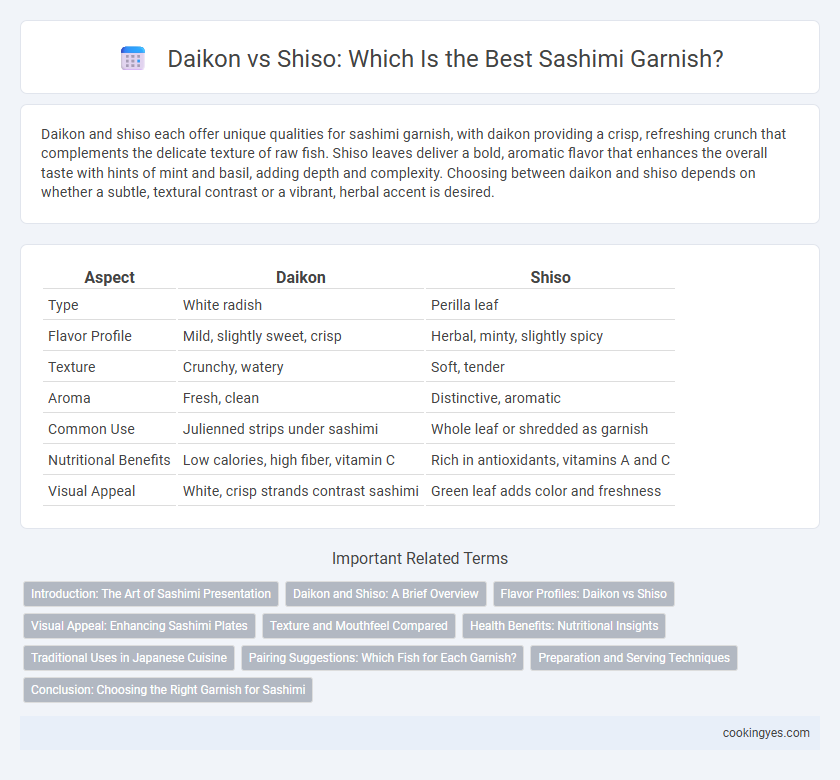Daikon and shiso each offer unique qualities for sashimi garnish, with daikon providing a crisp, refreshing crunch that complements the delicate texture of raw fish. Shiso leaves deliver a bold, aromatic flavor that enhances the overall taste with hints of mint and basil, adding depth and complexity. Choosing between daikon and shiso depends on whether a subtle, textural contrast or a vibrant, herbal accent is desired.
Table of Comparison
| Aspect | Daikon | Shiso |
|---|---|---|
| Type | White radish | Perilla leaf |
| Flavor Profile | Mild, slightly sweet, crisp | Herbal, minty, slightly spicy |
| Texture | Crunchy, watery | Soft, tender |
| Aroma | Fresh, clean | Distinctive, aromatic |
| Common Use | Julienned strips under sashimi | Whole leaf or shredded as garnish |
| Nutritional Benefits | Low calories, high fiber, vitamin C | Rich in antioxidants, vitamins A and C |
| Visual Appeal | White, crisp strands contrast sashimi | Green leaf adds color and freshness |
Introduction: The Art of Sashimi Presentation
Daikon and shiso both play essential roles in sashimi presentation by enhancing flavor and visual appeal. Daikon offers a crisp, subtle sweetness and a refreshing contrast that cleanses the palate between bites. Shiso provides a vibrant, herbal aroma and slight spiciness, elevating the sashimi experience with its distinctive taste and decorative green leaves.
Daikon and Shiso: A Brief Overview
Daikon and shiso are popular garnishes that enhance sashimi's presentation and flavor profile. Daikon, a white radish, offers a mild, slightly sweet crunch and acts as a palate cleanser, while shiso, a herb with a distinct minty and basil-like aroma, adds a refreshing, complex taste. Using daikon emphasizes texture and subtle sweetness, whereas shiso contributes vibrant herbaceous notes that complement raw fish varieties.
Flavor Profiles: Daikon vs Shiso
Daikon offers a mild, refreshing crunch with a subtle peppery undertone that complements the delicate flavors of sashimi without overpowering. Shiso provides a bold, aromatic profile featuring hints of mint, basil, and anise, adding a vibrant and slightly spicy contrast to the fish. Choosing between daikon and shiso depends on whether a clean, crisp palate cleanser or a herbaceous, complex flavor accent is preferred.
Visual Appeal: Enhancing Sashimi Plates
Daikon provides a crisp, white backdrop that highlights the vibrant colors of sashimi, creating a clean and elegant presentation ideal for traditional Japanese aesthetics. Shiso leaves contribute a rich green hue and serrated texture, adding visual contrast and a fresh, aromatic element that enhances the overall plate appeal. Combining daikon's subtle simplicity with shiso's bold presence creates a visually dynamic sashimi garnish that elevates the dining experience.
Texture and Mouthfeel Compared
Daikon offers a crisp, refreshing crunch that cleanses the palate between Sashimi bites, enhancing the fish's delicate flavors with its mild, slightly peppery taste. Shiso provides a softer, more tender texture with a unique, herbaceous aroma that lingers on the palate, creating a complex mouthfeel that contrasts with the smoothness of raw fish. The interplay of daikon's firm bite and shiso's leafy softness elevates the overall sensory experience, making each garnish choice essential for balancing Sashimi texture and flavor.
Health Benefits: Nutritional Insights
Daikon radish offers a rich source of vitamin C, digestive enzymes, and antioxidants that support immune health and aid in digestion, making it a functional garnish for sashimi. Shiso leaves provide anti-inflammatory benefits, high levels of vitamin A, calcium, and omega-3 fatty acids, enhancing both flavor and nutritional value. Incorporating either into sashimi not only complements the taste but also contributes essential nutrients that promote overall wellness.
Traditional Uses in Japanese Cuisine
Daikon radish and shiso leaves serve distinct traditional roles as sashimi garnishes in Japanese cuisine, with daikon providing a refreshing, crisp texture and mild flavor that cleanses the palate between bites. Shiso leaves contribute a vibrant, aromatic complexity with their unique herbal notes, enhancing the overall sensory experience and complementing the raw fish's taste. Both garnishes reflect centuries-old practices emphasizing balance and freshness, essential for the authentic presentation and enjoyment of sashimi.
Pairing Suggestions: Which Fish for Each Garnish?
Daikon pairs exceptionally well with richer fish like salmon and yellowtail, as its crisp, mildly spicy flavor balances the oily texture. Shiso complements delicate, lightly flavored sashimi such as tuna and sea bream, providing a fresh, aromatic herbal note. For optimal pairing, use daikon to enhance fatty fish sashimi and shiso to elevate leaner fish varieties.
Preparation and Serving Techniques
Daikon is finely shredded into thin, crisp strands that provide a mild, refreshing crunch and a neutral palate cleanser when served alongside sashimi. Shiso leaves are carefully washed and sometimes julienned or left whole to impart a distinctive, aromatic flavor with hints of mint and basil, enhancing the fish's taste. Presentation techniques for daikon involve creating a nest or bed for the sashimi, while shiso is often used as a decorative accent or wrapped around individual pieces for added texture and flavor complexity.
Conclusion: Choosing the Right Garnish for Sashimi
Selecting the ideal sashimi garnish hinges on flavor balance and texture contrast. Daikon offers a crisp, mild palate cleanser that enhances the fresh, delicate taste of raw fish, while Shiso imparts a bold, herbal zest with hints of mint and anise, elevating the dish's aromatic complexity. For purists seeking subtlety, daikon is optimal; those desiring an aromatic punch should opt for shiso to complement the sashimi experience.
Daikon vs Shiso for Sashimi Garnish Infographic

 cookingyes.com
cookingyes.com